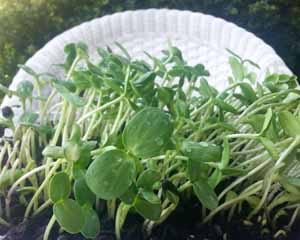by Jools Andrés, E-RYT200, RYT500, SOYA lead trainer in Vancouver. Used with permission from Jools’ blog, breathemovesit.com.
If you want to improve your nutritional habits and eat more fresh, raw food, nothing beats sprouting. Sprouts are rich in vitamins, minerals, and enzymes that aid digestion and protein assimilation, and are a true living food. You can have a continuous supply of salad and saute vegetables cycling through your daily intake at all times with very little outlay of money, time, or materials.
What you need:
- wide-mouthed jars
- cheesecloth
- sturdy rubber bands
- a colander or strainer
- seeds (always use organic seeds)
If you have never sprouted before, start with easy alfalfa. Put 1.5 tablespoons of alfalfa seeds in a litre/quart-sized (or larger) jar. Add an inch or two of cool tap or filtered water. Let soak for a maximum of 4 hours.
Cut several layers of cheesecloth to fit generously over the mouth of the jar and secure tightly with a rubber band.
Drain the seeds, rinse with fresh water, and drain again. Invert over a strainer or colander placed over a bowl or in the dish drainer over the sink. Rinse and drain morning and evening for 4-5 five days. Try to keep in a darkish area of the kitchen.
To refine the presentation of any sprouts, submerge them (fully grown) in lots of cool water in a large pot or stainless steel bowl. Swirl them around gently but thoroughly with your fingers to remove as many seed husks as possible, then gently return them to the jar. Take a moment to regard how they sparkle with life. There will be a little production loss, but it is worth it as it makes the sprouts extra tasty and they tend to stay fresh a little longer.
Drain the sprouts well and place them in a brighter location (never in direct sunlight) for a few hours to let them green up, then cover with a tight lid and place in the fridge.
Add variety
clover (similar to but sweeter and paler than alfalfa)
lentil (can be eaten raw or lightly cooked; nice in mixes)
mustards: canola, radishes, broccoli, etc. (some can be very zingy!)
fenugreek (strong “curry” overtones; best in mixes in small proportions; can be bitter when cooked)
garbanzos (excellent lightly cooked or in raw hummus)
black beans (crunchy and potent; best cooked lightly)
mung beans (excellent in stir fry or lightly steamed for warm salad)
buckwheat (sprouted and re-dried; great over your favourite breakfast cereal or sprinkled on salads)
Find mixes you like. I prefer beans, buckwheat, and lentils just barely sprouted, probably within 48 hours of initial soaking. The exception is mung beans, which take about 7-8 days. I grow them in complete darkness to reduce bitterness and maintain a pale colour. I sprout brassicas and mustard in very small amounts (1 teaspoon or less of seeds) and start new batches every 4-5 days.
Microgreens
A couple of years ago I started growing microgreens, indoors and out, and manage to easily produce year-round greens for salads, sandwiches, and smoothies. Microgreens are much easier to digest than fully grown plants, so their nutrients are assimilated more readily by the body. Soil is needed as a medium for growing these potent and incredibly delicious sprouts, which can create minor involvement with composting and soil recycling. This is a rich process that brings its own rewards and takes very little time or space–more on that another time.
Start with sunflower sprouts. Plump and substantial, I love these in smoothies at breakfast or a handful as garnish for any dish.
Use a flat, drainage-efficient growing vessel with trays underneath to protect from leakage. (I use dense compostable paper trays that I save from organic nursery bedding plant purchases. You can also use plastic trays cut from blueberry or strawberry packs from the supermarket.) Purchase a small bag of organic soil if you don’t have access to the ground somewhere. A spray bottle is nice to have on hand for frequent misting.
Purchasing online with West Coast Seeds or another seed supplier is more economical over long term than buying the expensive, tiny packets available (when you can find them) in health food stores. Find a supplier that honours heirloom seed integrity (non GMO/GEO) and uses organic growing practices. Try arugula, beets, Chinese cabbages, kale, peas, and others for a great variety of tastes and textures. Harvest when the first leaf pairs are fully opened and before the secondary leaves form.
It takes me about half an hour a week to have a constant supply of these scrumptious dietary powerhouses. Be patient and learn from any unsuccessful attempts. Once you get the hang of it, it can become a pleasing ritual. Best of all, you will be blown away by their goodness.
Thank you for reading.
Jools
 Jools Andrés, E-RYT200, RYT500, is a lead trainer for the SOYA Yoga teacher training in Vancouver. She and artist Kathleen Ainscough are holding an immersion retreat entitled “Creative Embodiment: Portal to the Present” combining yoga and creative expression on April 8-10 on Bowen Island. Visit the website at wildonionretreats.com.
Jools Andrés, E-RYT200, RYT500, is a lead trainer for the SOYA Yoga teacher training in Vancouver. She and artist Kathleen Ainscough are holding an immersion retreat entitled “Creative Embodiment: Portal to the Present” combining yoga and creative expression on April 8-10 on Bowen Island. Visit the website at wildonionretreats.com.Mung bean and sunflower sprouts photos by Jools Andrés.




Recent Comments